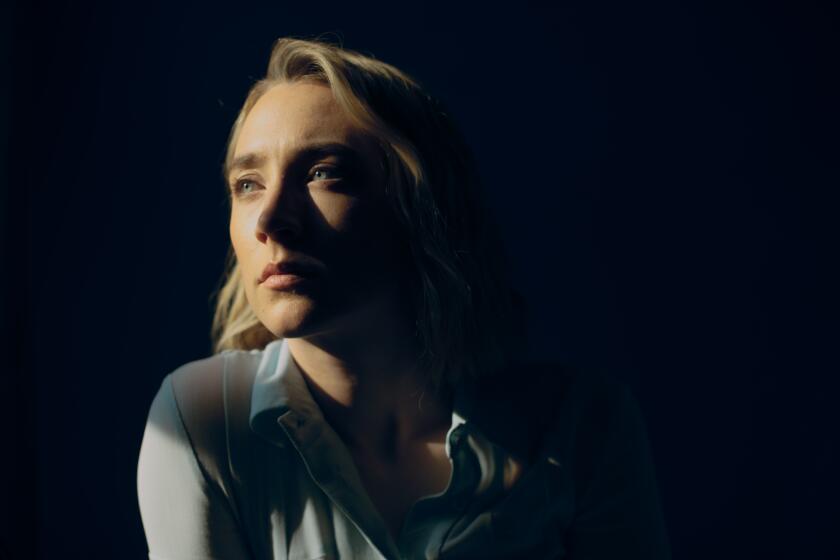NUNN’S STORY: A CHALLENGE IN ‘LADY JANE’
DOVER, England — It was the end of a trying week. Dover Castle was cold and damp, and strong winds blew in from the sea. About 200 crew members and actors walked around in Wellington boots, scarfs and parkas wrapped around long woolen robes and armor breastplates. Fifty horses pawed the ground and neighed in a makeshift stable, waiting for the sun to shine long enough to film Lady Jane Grey’s execution. The day before, producer Peter Smell and writer David Edgar had been called in for a last-minute script conference.
The sun finally broke through the gray rain clouds early in the morning. Director Trevor Nunn--dressed like a Mongolian herdsman in a heavy Shetland sweater, parka, corduroys and boots--used every ray to film young Helena Bonham Carter and Cary Elwes as they walked somberly to the scaffold.
This may seem unlikely fare for moviegoers weaned on battles between planets--and not Plantagenets: a love story about a 15-year-old Tudor queen and her 17-year-old cousin who rule England for just nine days and are then beheaded in the Tower of London. But Nunn thrives on transforming esoteric matter into compelling entertainment.
About four years ago, he reshaped Charles Dickens’ ponderous saga of “Nicholas Nickleby” into a stunning theatrical event that garnered awards on both sides of the Atlantic. Shortly after, he transformed 10 isolated T. S. Eliot poems about some down-and-out opossums into the haunting musical “Cats.” Last year, he electrified audiences with his glitzy presentation of roller-skaters zooming their way through adolescence on a “Starlight Express.” And next year, he plans to do a musical version of Victor Hugo’s somber epic, “Les Miserables.”
Even so, “Lady Jane Grey,” which finished shooting early this month, presented new challenges for Nunn. It was the first feature film that he’d taken on (although he filmed his own stage version of “Hedda Gabler” in 1975).
“It’s a totally different method and pattern of work,” he admitted during a late lunch break.
“I’ve worked in TV studios many times and know what it’s like to look through a lens and to coordinate five different cameras, but I do feel vulnerable and inexperienced and have developed a huge admiration for certain film directors.”
He seemed tense and tired. But he was also buoyant, albeit a bit guarded, about the new project.
“Of course, I’m enjoying it hugely because after working for so long in the theater, it’s thrilling to discover 1,000 new things every day. There’s a high-risk element. The depressing aspect is that there continue to be 1,000 things to learn every day--I speak gamely and defensively,” he said with a slight laugh.
“I would not have agreed to do absolutely any film that came along, but I’ve wanted to make one for a number of years. And after I turned down a script from Jeff Katzenberg that turned out to be ‘Flashdance’--because in my heart I’m still a classicist--I bumped into Jeff in the Russian Tea Room in Manhattan. I said, ‘You owe me a lot of money and a favor for not doing “Flashdance” because I would have lost money for Paramount,’ and several months later he sent me a script that he said was right for a classicist.”
The legend of Lady Jane Grey is well known in England. When Henry VIII died in 1547, the throne passed to Edward VI, Henry’s son. Upon the death of the 15-year-old Edward, John Dudley, Earl of Warwick, devised a political coup to prevent the accession of Edward’s half-wit sister, Mary, by placing Henry’s great-niece, Lady Jane Grey, on the throne. Dudley also forced Jane to marry his oldest son, 17-year-old Guilford, to cement the coup. Ironically, the two cousins fell in love after they were married. But they were all undone when Mary staged an insurrection, imprisoned the young lovers and beheaded them for treason.
Nunn notes: “It’s a marvelously dramatic plot--if it hadn’t happened in history, it would be immensely difficult to believe--but it has all the ingredients of a great tragedy, extraordinary political thriller and ultimate love story.
“In every age we have a need for exemplary stories about people who can do things for reasons having nothing to do with ambition or greed. I’m hoping to present something truly tragic that is also visionary.”
Nunn knows that he needs more than vision to do the job. He has begun by surrounding himself with familiar colleagues. The supporting members of the cast are actors from the Royal Shakespeare Company, where he’s been artistic director for more than 15 years--Don Wood, Michael Hodson, Patrick Stewart and Sara Kestelman. He also enlisted writer David Edgar, who wrote the script for “Nicholas Nickleby,” and photographer Douglas Slocombe, who filmed “Hedda Gabler.”
But he’s taking a gamble on his female lead. Carter, 18, who portrays Lady Jane, has a winsome pre-Raphaelite face and lively intelligence, but has performed in only one TV role and intends to enter Oxford after the film is completed. Elwes, 21, a Robert Redford look-alike who plays Guilford, is a relative veteran, having performed in “Another Country.”
And there’s certainly a good chance that Nunn, 44, will bring the film off, since his career has been studded with unlikely triumphs. The son of a cabinet maker from Ipswich, East Anglia, he saw his first play, “Robin Hood,” at the age of 8 and decided on the spot to have a dramatic career. As a child, he delivered dramatic readings and acted in small parts. He was also an outstanding student who passed his school exams with such high marks that he was admitted to a scholastic grammar school, unlike other working-class children.
After graduation, he taught school and founded a local drama society. Then he entered Cambridge. He acted and directed with the Marlowe Society and struck up a friendship with Peter Hall, who later hired Nunn as an assistant director when he became the head of the Royal Shakespeare.
In 1965, the 25-year-old Nunn staged a production of Cyril Tourner’s blood-filled Jacobean drama, “The Revenger’s Tragedy.” “For years, I was known as the director of ‘The Revenger’s Tragedy,’ ” he recalled. “I no longer have to look up to that. Now, it’s ‘Nicholas Nickleby.’ ”
In 1968, he succeeded Peter Hall as artistic director of the Royal Shakespeare Company, becoming the youngest man ever to head it. The next year, he married actress Janet Suzman, who performed in many of his productions. (They separated several years ago, shortly after the birth of their only son, Joshua.)
At the Royal Shakespeare, he earned a reputation as a director who took risks and invested classical plays with ingenious twists, novel casting and staging.
In “Nicholas Nickleby”--which he did as a stop-gap measure to save the Royal Shakespeare Company from bankruptcy--he cast 45 actors in 150 parts, used costumes from junk shops and rebuilt the theater with catwalks, runways, bridges and movable platforms.
In “Cats,” he designed the stage as a “rubbish dump” with catwalk and circular platform to approximate the kind of place where “tumbledown” cats really live. And in “Starlight Express,” he rebuilt the Apollo movie house in London’s West End with roller-skating alleys that encapsulate two levels, a star-studded dome and video screen.
People who know Nunn say he is intense and totally focused on a project once it gets under way, often overworking himself--and his performers--to the point of exhaustion. Even so, performers tend to respect his zeal.
“It’s a dream that sometimes turns into a nightmare,” said the youthful, dark-haired Carter. “There are extraordinary demands. Working with Trevor is exhilarating and exciting, but at first I was incredibly daunted by his pace. He brings out your emotions by having long talks with you and making you remember what terrifying experiences you’ve gone through. He’s also a brilliant actor who demonstrates what he wants and allocates the same amount of time to everyone.”
Nunn is clearly a perfectionist and can rehearse one small gesture for an hour. “In theater you go over and over difficult problem areas. And you polish them partly to provide absolute clarity and partly so events will be endlessly repeatable night after night.
“But in cinema, it is pretty vital that most people don’t know what’s going on most of the time so they can respond to what is happening from their limited point of view without knowing what the end result will be. The more rehearsed it is in cinematic terms, the less successful it will be.”
Whether he succeeds won’t be known until October when the film is scheduled for release. “Clearly, the success of ‘Nicholas Nickleby’ opened the door to making a film--and it’s quite possible that door will slam shut again. I still do have a huge amount to learn.”
More to Read
Only good movies
Get the Indie Focus newsletter, Mark Olsen's weekly guide to the world of cinema.
You may occasionally receive promotional content from the Los Angeles Times.










